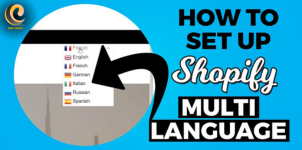How to Create a Multi-Language Shopify Store to Reach a Global Audience
As the e-commerce landscape grows globally, reaching a wider audience is essential for scaling your business. Adding multiple languages to your Shopify store enables you to connect with international customers in a more personalized way, building trust and driving conversions. Whether you’re taking a Shopify course in Lahore or enrolled in the best Shopify course online, mastering multi-language functionality is a valuable skill to make your store competitive worldwide. This guide will walk you through creating a multi-language Shopify store, with insights and tips from Shopify training to help optimize your setup for SEO and user experience.
1. Why a Multi-Language Store Matters for Global Growth
Creating a multi-language Shopify store allows you to provide customers with an experience in their native language, helping to bridge cultural gaps and increasing trust. With a localized approach, you’re likely to see improvements in conversion rates, as customers feel more connected to a store that communicates in their preferred language.
International reach is particularly important for competitive markets like Pakistan, where localized content can attract a more diverse customer base. This applies whether you’re focused on a Shopify course in Pakistan, engaging in Shopify online courses, or specifically targeting dropshipping audiences.
2. Steps to Create a Multi-Language Shopify Store
Step 1: Choose the Right Shopify Plan and Apps
To enable multi-language features on Shopify, it’s best to use Shopify’s Advanced or Shopify Plus plan. These plans support third-party apps and custom coding required to create a seamless multi-language experience.
Shopify also offers various apps like Langify, Weglot, and GTranslate, which help manage multiple languages easily. Taking a Shopify full course or Shopify training on multi-language app integrations can give you the expertise to navigate these tools and maximize their potential.
Step 2: Add Language-Switcher to Your Shopify Store
Once you’ve selected a language app, add a language-switcher to your Shopify store. This small widget allows users to switch between languages easily. The location of the switcher should be intuitive—typically at the top of the page, where it’s easy to spot.
For an effective setup, many Shopify courses emphasize usability and recommend user-testing to ensure the switcher provides a seamless experience.
Step 3: Translate Content
Next, focus on translating your website content. Ensure that your translations are accurate and culturally appropriate, especially for sensitive markets. Most apps offer automatic translation, but manual adjustments can make a significant difference. It’s a good idea to focus on translating key pages like the homepage, product pages, checkout, and contact page.
Investing in Shopify online courses on content localization or taking a Shopify course in Lahore can be valuable if you’re targeting specific regions and languages.
Step 4: Optimize for Multi-Language SEO
SEO is critical for each language variation of your site to ensure that it ranks well on search engines. Shopify apps like Weglot and Langify allow you to create SEO-friendly URLs for each language. Make sure to use hreflang tags and translate meta titles, descriptions, and alt texts for images. SEO insights from Shopify training will help you optimize these aspects, which are crucial for reaching a global audience.
Step 5: Test User Experience Across Languages
Finally, test the user experience for each language version of your store. Ensure that all content appears as intended, especially during the checkout process. Regularly monitor each language for any inconsistencies or areas for improvement. Engaging in a Shopify dropshipping course can provide insights into best practices for multi-language user experience, especially if your store offers international shipping.
3. Best Practices for Running a Multi-Language Shopify Store
Running a multi-language Shopify store requires ongoing effort. Here are some tips to ensure you maintain an effective setup:
- Focus on Core Languages First: Start with a few key languages that make up a significant portion of your traffic, then expand over time.
- Optimize Loading Speed: Multi-language apps can sometimes slow down a website. Regularly test your website speed and optimize image sizes and scripts.
- Localize Content Beyond Translation: Consider cultural elements such as currency and localized product offerings. Localizing specific promotions based on regions can boost engagement.
- Keep an Eye on Analytics: Track the performance of each language version, including bounce rates and conversion rates, to assess the effectiveness of your translations and adjust as needed.
Completing a Shopify course or Shopify training with a focus on international e-commerce can help you learn how to track and analyze these metrics.
4. Leveraging Shopify Courses for Multi-Language Success
If you’re new to Shopify or want a structured approach to expanding globally, consider taking a Shopify course that covers international marketing and multi-language functionality. Here are some recommended courses:
- Shopify Free Course: Provides a foundation for Shopify basics, including essential tools and settings.
- Best Shopify Course: Offers in-depth training on Shopify features, including multi-language setup.
- Shopify Dropshipping Course Free: Focuses on dropshipping but includes insights on global expansion strategies.
- Shopify Training on Localization: A targeted course that helps understand market-specific needs and how to tailor your store accordingly.
Investing time in one of these courses will give you a clearer understanding of how to build a multi-language Shopify store optimized for global customers.
5. Conclusion: Reach a Global Audience with a Multi-Language Shopify Store
Expanding your Shopify store to multiple languages can open the door to a much wider customer base and boost sales. By following these steps and using Shopify’s multi-language apps, you’ll be well-equipped to deliver an enhanced user experience. Incorporating insights from a Shopify course in Lahore, Shopify dropshipping course, or the best Shopify course will give you a valuable edge as you expand your store internationally.
Whether you’re targeting customers locally or globally, a multi-language store ensures that you’re not limited by language barriers, allowing you to reach your full e-commerce potential.

